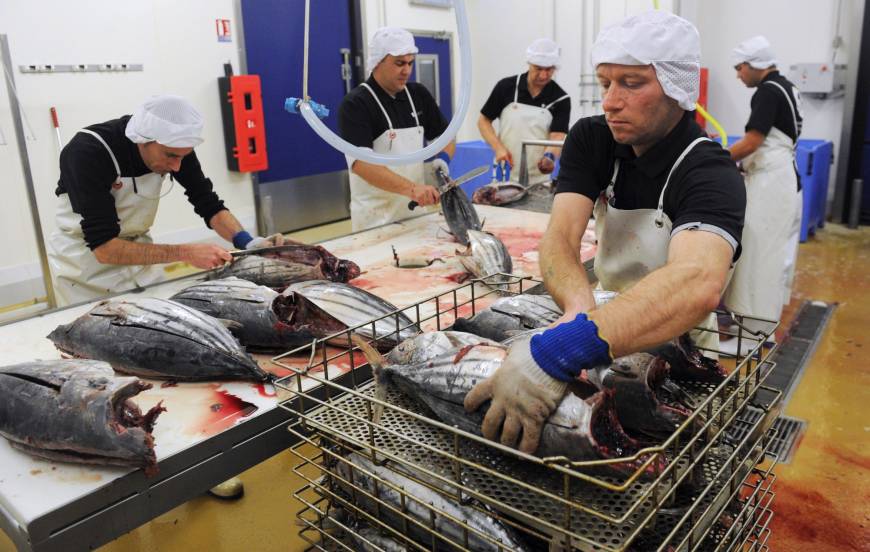マイケルズイングリッシュスクール英会話 大阪天王寺 毎週の単語レッスン
Authentic bonito flakes – now made in France?
鹿児島県枕崎市のかつお節業者らが、仏北西部ブルターニュ地方でかつお節の生産工の操業を開始した。和食人気の高まりを受け、欧州市場向けに現地で本格的なかつお節作りに挑んでいる。

-
欧州で「本物」のかつお節を
They came to France from Japan with one idea: to establish a factory for authentic dried bonito flakes, a key ingredient in Japanese cuisine rare in Europe.
Dried bonito fish, or katusobushi, has a distinct umami flavour. It is essential in dashi, a stock that forms the basis of much Japanese cuisine. However, authentic bonito has largely been unavailable to European chefs as it cannot be exported from Japan to Europe. Now that Japanese cooperative Makurazaki has opened its production facility in Brittany, northwestern France, that\’s set to change.
\”It was crucial to be passionate about this product and the aim of this project for it to see the light of day,\” says Gwenael Perhirin, director of Makurazaki France.
Makurazaki, which takes its name from the city in Kagoshima Prefecture famous for its katsuobushi, represents a packaging company, fishing cooperative and eight manufacturers of bonito flakes and other products derived from fish of the tuna family.
-
中国産や韓国産や入手できるが…
Bonito flakes that can be found in shops across the European Union. However, they mostly come from China, South Korea or Vietnam. As well as this, they can cost up to 130 euros (¥16,000) per kilogram.
\”It is not at all the same product in terms of taste and smell,\” says Perhirin.
In 2013, UNESCO recognised washoku as part of Japan\’s intangible cultural heritage. Therefore, Makurazaki is hoping to make good on the growing wave of interest in Japan\’s culinary traditions.
Located in the seaside town of Concarneau, the 800-sq.-metre factory was opened in early September. Makurazaki has spend 2 million euros (¥247 million) in the plant after signing a deal with Concarneau-based French tuna firm CFTO (Compagnie Francaise du Thon Oceanique).
CFTO:
Under the deal, CFTO will supply Makurazaki France with 3 to 6 tons of bonito each week. This is also known as skipjack tuna. At present, the plant can turn a ton of fish into 200 kilograms of katsuobushi.
CFTO runs a fleet of 14 vessels in the Atlantic and Indian oceans. It catches bonito according to strict regulations.
Once caught, staff freeze the fish onboard. They then bring it back to port, defrost it and cut it into filets.
Staff then cook and smoke-dry the fish. Afterwards, it is matured in a process involving mould, and finally shredded. The packaging process is also very strict. This is because the product quickly deteriorates when it comes into contact with the air. As such, it must not be exposed to moisture.
Five locally hired workers carry out most of the operations. Two Japanese experts from Makurazaki train them on site.
\”The quality of our finished product is much closer to what we produce in Japan,\” says Atsushi Kawazoe, one of the experts. \”There is still progress to be made but we\’re nearly there.\”
Makurazaki is hoping to initially supply high-end Japanese restaurants. And after this, trying to introduce the product to French chefs, and eventually extending its reach into other European countries.
\”Even the Emperor of Japan knows about us,\” says Perhirin. \”It\’s a bit of a crazy project.\”
フランス産でも「本物の」かつお節の単語
If you\’re interested in learning vocabulary through news and current affairs, check back every Saturday for another article!
The aim of the articles is to be short enough to easily digest. Nonetheless, we want to provide important new words. Furthermore, we deliberately choose topics that you\’ve probably heard in the news already. This makes them relatable and easier to understand. Could you tell your teacher about this news story, in English? Try to practice recounting the story, or even rewriting it in your own words. Afterwards, you can show it to your teacher for correction. Additionally, you could also try a translation of the article. This is an intellectually stimulating exercise. which is both fun and great practice for understanding the different ways of thinking between English and Japanese. Finally, please remember to have fun learning English! The most rewarding thing for us at Michael\’s English School is seeing your results. See you next time!

